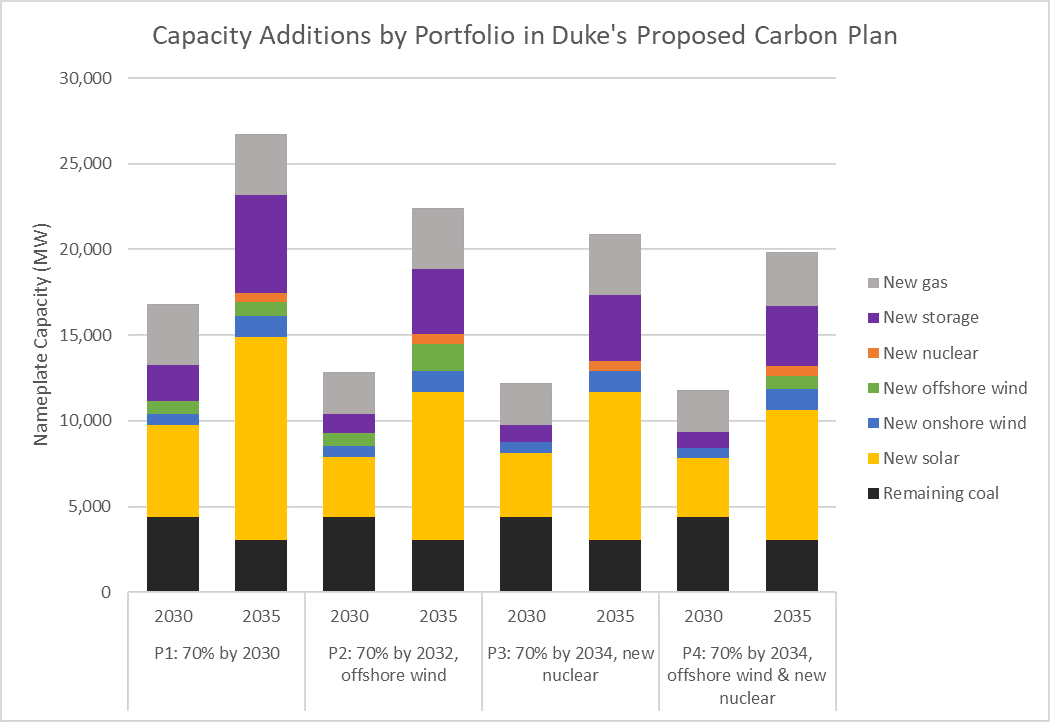Duke has submitted its proposed Carbon Plan to the North Carolinas Utilities Commission (NCUC). This plan is one of the inputs the NCUC will use to compose its Carbon Plan as required by HB 951 by December 31, 2022. Duke’s filing, and all the documents filed related to the Carbon Plan, are available on the NCUC’s website for the Carbon Plan docket (#E-100, Sub 179).
Duke seeks Commission approvals
Let’s start with what Duke is asking of the Commission. As part of its submission, Duke has asked the Commission to approve its plan as-is, without picking a preferred portfolio (Duke presents four main portfolios), and to approve Duke’s near-term actions, including:
- Begin the Public Policy Transmission project process in 2022
- Procure 3,100 MW of solar from 2022-2024, including 750 MW in 2022, with a targeted in-service in 2026-2028
- Conduct development and begin procurement of 1,600 MW of battery storage, 600 MW of which will be paired with solar
- Procure of 600 MW of onshore wind in 2023-2024
- Submit Certificate of Public Convenience and Necessity (CPCN) for 2 gas combustion turbine (CT) plants totaling 800 MW and 1 gas combined cycle (CC) plant totaling 1,200 MW for a total of 2,000 MW of new gas in 2023
- Perform initial activities supporting the future availability of offshore wind, small modular reactors (SMRs), and new pumped storage at Duke’s existing location at Bad Creek
- Expand the flexibility of the existing gas fleet and the pursuit of the renewal of licenses at existing nuclear facilities
- Advance the “Grid edge and customer programs” proposal
- Establish HB 951 as a new public policy goal so that it can be studied as part of the NCTPC
- Postpone Duke’s next Integrated Resource Plan (IRP) process until 2024, when it would align with the next update of the Carbon Plan
Duke presents four portfolios
Duke modeled four scenarios in its draft Carbon Plan that resulted in four portfolios, or sets of planned generation additions and retirements, without recommending a preferred option. The first thing to know about these four portfolios is that only one of them (“P1”) meets the target laid out in HB 951 to reduce emissions by 70% from 2005 levels by 2030. One of the portfolios (“P2”) achieves a 70% reduction by 2032, and the other two portfolio (“P3” & “P4”) achieve that level of carbon reductions by 2034, four years after the legislated deadline. While HB 951 does allow the Commission to delay the carbon reduction goals, it is surprising to see Duke suggest to delay the first goal right from the start.
In each of these portfolios, Duke assumed the same level of energy efficiency and demand-side options. In its proposed plan, Duke calls these resources “Grid Edge” contributions, and they include energy efficiency, demand response, customer self-generation, voltage management, and other distributed energy resources (DERs). While Duke has increased the amount of demand-side resources from its IRP, the response during the stakeholder process was that Duke’s assumed energy efficiency cap (1% savings net of opt-outs) is too low. Both North and South Carolina give large commercial and industrial customers an “opt-out” option, meaning many businesses do not contribute to either the cost of – nor savings from – utility efficiency programs in the Carolinas.
The chart below shows the cumulative capacity additions in each portfolio by 2030 and 2035. Perhaps the first thing notable is how similar all of these portfolios are. They all have the same amounts of coal remaining in both 2030 and 2035, and similar amounts of new gas proposed (between 3.1-3.5 MW total of new gas by 2035 for all portfolios). Each portfolio has no new nuclear by 2030 but 570 MW of new nuclear by 2035, and each portfolio assumes 600 MW of onshore wind comes online by 2030 and 1,200 MW of onshore wind comes online by 2035.
The portfolios do vary by the timing and amount of storage, solar, and offshore wind additions. The portfolio that achieves a 70% reduction by 2030, P1, has the most new solar by 2030 (5,400 MW) and by 2035 (nearly 12,000 MW), and the most new storage by 2030 (just over 2,000 MW) and by 2035 (just over 5,600 MW). Two of the portfolios, P1 and P2, assume 800 MW of offshore wind comes online by the end of 2030, with P1 not adding any more offshore wind by 2035, while P2 adds another 800 MW for a total of 1,600 MW of offshore wind by 2035.

Another way to examine the proposed capacity additions (called portfolios) in Duke’s draft Carbon Plan is to compare these to the portfolios Duke presented in its latest IRP. As a part of its 2020 IRP filings, the South Carolina Public Service Commission (PSC) required Duke to file a modified IRP that adjusted key assumptions on gas price forecasts, solar costs, and storage. Below is a chart that shows a comparison of the range of cumulative capacity additions by 2035 for all the portfolios presented in Duke’s proposed Carbon Plan and its modified IRP. While the solar, storage, and energy efficiency ranges have generally increased, the new gas range has narrowed, and the coal remaining on the system is generally higher in the proposed Carbon Plan (though is dual fuel, meaning it can be run all or in part of natural gas).

Also notable is that all of the proposed Carbon Plan portfolios include new nuclear or onshore wind, whereas two of the portfolios in Duke’s 2020 modified IRP included no new onshore wind by 2035 (portfolios “A1” and “A2) and only two of the portfolios in Duke’s 2020 modified IRP included new nuclear by 2035 (“E1” and “F1).
Public Policy Transmission Projects
In its filing, Duke proposes to initiate the process for the North Carolina Transmission Planning Cooperative (NCPTC) to approve transmission projects necessary to allow substantial incremental solar to interconnect in a region in the Carolinas known as the “Red Zone” area because any new generation resource that tries to interconnect in that area triggers expensive transmission upgrades. Because the transmission upgrades triggered by a project are required to be paid for by the project developer, the existence of this red zone has hampered solar development in the area. Appendix P of Duke’s draft Carbon Plan layout 17 transmission projects for a total of $560.5 million that would proactively open up the red zone for solar development. Those projects still need to move through the NCPTC process, and the timing of when the construction of the transmission projects could start is still unclear. Duke also makes clear that additional transmission investments will be needed to meet the 2050 net-zero goal, and it plans to work through the NCTPC forum to study how new transmission can support the achievement of the carbon reduction goals laid out in HB 951.
Hydrogen
Duke’s analysis assumes it can blend hydrogen into the natural gas used at its existing gas CC and CT plants beginning in 2035, that all new CT plants built in 2040 or beyond operate on 100% hydrogen, and that all CC and CT units that remain in operation by 2050 will operate on hydrogen. Duke also assumes in its modeling that new CC and CT plants will be designed with hydrogen capability, but does not specify how the costs of this assumption were included in the analysis, including the cost to either build out a new hydrogen pipeline system or retrofit existing gas pipelines to be able to transport hydrogen. Duke’s proposal, in Appendix O, states that “Currently, the most significant limitations to the adoption of hydrogen as a decarbonization solution are the cost of production, storage, transportation and the volume of supply.” This is to say, the entire supply chain of hydrogen needs significant improvements before it can become a viable option to replace gas as a fuel for electricity generation.
New Nuclear
As seen above, all of Duke’s portfolios assume 570 MW of small modular reactors (SMR) new nuclear is built by 2035. Duke’s modeling assumed 2032 was the earliest date new nuclear could come online. While there are a few projects underway, there are no SMR projects currently operational anywhere in the world.
Next steps + Get Involved
Duke’s draft plan is a key piece to the puzzle but is only one item the NCUC will consider as it puts together a final Carbon Plan by the end of the year. There are a few ways to plug into the process between now and then.
First, as intervenors, SACE will be working with our co-intervening organizations to develop comments about Duke’s proposed plan and likely to suggest our own alternative plan.
The NCUC will hold four in-person public hearings where members of the public can speak directly to Commissioners about what they want to see in the final Carbon Plan.
In-Person Hearings
- July 11 | Durham | 7 PM | Durham County Courthouse, Courtroom D7, 510 S Dillard Street
- July 12 | Wilmington | 7 PM | New Hanover County Courthouse, Courtroom 317, 316 Princess Street
- July 27 | Asheville | 7 PM | Buncombe County Courthouse, Courtroom 1-A, 60 Court Plaza
- July 28 | Charlotte | 7 PM | Mecklenburg County Courthouse, Courtroom 5350, 832 E 4th Street, Charlotte
Virtual Hearings
In addition to the in-person public hearings, the NCUC will hold two virtual hearings:
- August 23 | 1:30 PM ET
- August 23 | 6:30 PM ET
Only the first 20 people registered for each remote hearing session will be allowed to testify. Members of the public wishing to testify at the remote hearing must register in advance by 5 PM ET, August 16, 2022, by emailing the Commission at ncucpublichearing@ncuc.net or by calling 919-733-0837. People who want to register are required to provide their name, the docket number (E-100 Sub 179), the telephone number that they will use to participate in the hearing, and the topic of their testimony. People who simply want to observe a remote hearing may do so via the live stream link on this website.
Written Comments
In addition, the Commission Carbon Plan website states that “any person or entity may submit written statements to inform the Commission of their positions on the Carbon Plan.” To electronically submit a position statement, the Commission asks that you use its website contact form, and reference Docket Number E-100, Sub 179, so the Commission knows your comment is related to the Carbon Plan.
More information, and instructions on subscribing to the Carbon Plan docket, are on the NCUC’s Carbon Plan landing page.
#NCCarbonPlan



